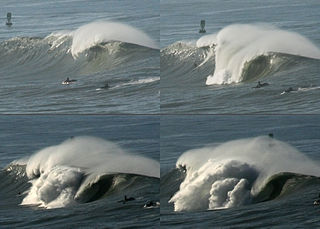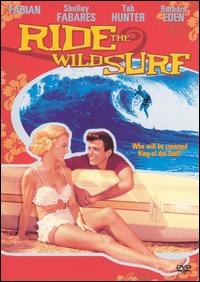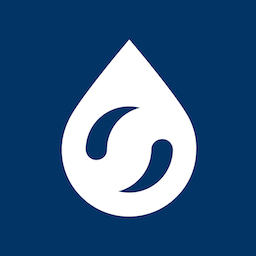Related Research Articles

Surfing is a surface water sport in which an individual, a surfer, uses a board to ride on the forward section, or face, of a moving wave of water, which usually carries the surfer towards the shore. Waves suitable for surfing are primarily found on ocean shores, but can also be found as standing waves in the open ocean, in lakes, in rivers in the form of a tidal bore, or in wave pools.

Train surfing is typically a reckless, dangerous, and illegal act of riding on the outside of a moving train, tram, or other forms of rail transport. In a number of countries, the term 'train hopping' is used synonymously with freight hopping, which means riding on the outside of a freight train, while train surfing can be practiced on any type of train. This type of travelling can be extremely dangerous and even life-threatening, because there is a risk of death or serious injury due to falling off a moving train, electrocution by the power supply, colliding with railway infrastructure such as bridges, tunnels, station platforms, trackside buildings, railway signals or other trains, while riding outside off structure gauge on the side or on the roof of a train, or unsuccessful attempts to jump onto a moving train or off it. Today, the practice is illegal by statutes on many railroads in the world. Despite this, it is still practiced, especially on those railroads where the trains are overcrowded.

Mavericks is a surfing location in northern California outside Pillar Point Harbor, just north of the town of Half Moon Bay at the village of Princeton-by-the-Sea. After a strong winter storm in the northern Pacific Ocean, waves can routinely crest at over 25 ft (8 m) and top out at over 60 ft (18 m). Routinely, waves that break can be recorded on seismometers. The break is caused by an unusually shaped underwater rock formation.

Laird John Hamilton is an American big-wave surfer, co-inventor of tow-in surfing, and an occasional fashion and action-sports model and actor. He is married to Gabrielle Reece, a former professional volleyball player, television personality, and model.

A leg rope or surfboard leash is a urethane cord attached to the deck of a surfboard, down near the tail. It prevents the surfboard from being swept away by waves and stops runaway surfboards from hitting other surfers and swimmers. Modern leashes consist of a urethane cord where one end has a band with a velcro strap attached to the surfer's trailing foot, and the opposite has a velcro strap attached to the tail end of the surfboard. Should the surfer fall while riding a wave, the surfboard will not be swept away, thus allowing the surfer to quickly recover his surfboard and return to the take-off zone.

Surf's Up is a 2007 American animated mockumentary comedy film produced by Columbia Pictures and Sony Pictures Animation, and distributed by Sony Pictures Releasing. It was directed by Ash Brannon and Chris Buck from a screenplay they co-wrote with Don Rhymer and producer Chris Jenkins, based on a story by Jenkins and Christian Darren. The film stars the voices of Shia LaBeouf, Jeff Bridges, Zooey Deschanel, Jon Heder, and James Woods. It is a parody of surfing documentaries, such as The Endless Summer and Riding Giants, with parts of the plot parodying North Shore. Real-life surfers Kelly Slater and Rob Machado have vignettes as their penguin surfer counterparts. To obtain the desired hand-held documentary feel, the film's animation team motion-captured a physical camera operator's moves.

The World Surf League (WSL) is the governing body for professional surfers and is dedicated to showcasing the world's best talent in a variety of progressive formats. The World Surf League was originally known as the International Professional Surfing founded by Fred Hemmings and Randy Rarick in 1976. IPS created the first world circuit of pro surfing events. In 1983 the Association of Surfing Pros took over management of the world circuit. In 2013, the ASP was acquired by ZoSea, backed by Paul Speaker, Terry Hardy, and Dirk Ziff. At the start of the 2015 season, the ASP changed its name to the World Surf League. Sophie Goldschmidt was appointed as WSL CEO on 19 July 2017. Paul Speaker had stepped down as CEO on 11 January 2017, and Dirk Ziff acted as the interim WSL CEO until Goldschmidt's appointment.

The Eisbach is a 2-kilometre-long (1.2 mi) man-made river in Munich. It flows through the Englischer Garten park, and is a side arm of the Isar River. An artificial wave has been created on one section, which is popular among river surfers.

The riding of waves has likely existed since humans began swimming in the ocean. In this sense, bodysurfing is the oldest type of wave-catching. Undoubtedly ancient sailors learned how to ride wave energy on many styles of early boats. Archaeological evidence even suggests that ancient cultures of Peru surfed on reed watercraft for fishing and recreation up to five thousand years ago. However, standing up on what is now called a surfboard is a relatively recent innovation developed by the Polynesians. The influences for modern surfing can be directly traced to the surfers of pre-contact Hawaii.

River surfing is the sport of surfing either standing waves, tidal bores or upstream waves in rivers. Claims for its origins include a 1955 ride of 2.4 km (1.5 mi) along the tidal bore of the River Severn.

Tube riding is a term used by surfers to describe riding well inside the curve or barrel of a finely-shaped breaking wave. Under the right conditions, waves in some areas, such as the Banzai Pipeline in Hawaii, form a moving "tube" or cylinder as they break.
Dave Kalama is a big wave surfer/tow-in surfer, stand-up paddle (SUP) surfer and racer, surf and SUP board shaper, windsurfer, outrigger canoe racer, private adventure guide, and celebrity watersports enthusiast. Kalama, his wife, 2 sons and 1 daughter live in Kula, Maui.

Ride the Wild Surf is a 1964 American romantic drama film. It was filmed in 1963 and distributed in 1964. Unlike the beach party movies of the era, this was a departure from the typical Hollywood approach to surfing as it was a drama, not a comedy. It is known for its exceptional big wave surf footage – a common sight in surf movies of the time, but a rarity in Hollywood films. Likewise, the film has only one pop song – the titular Jan and Dean track, which is heard once, at the end of the film.

This glossary of surfing includes some of the extensive vocabulary used to describe various aspects of the sport of surfing as described in literature on the subject.[a][b] In some cases terms have spread to a wider cultural use. These terms were originally coined by people who were directly involved in the sport of surfing.

Surfline is a company and website based in Huntington Beach, California that specializes in surf forecasting and surf reports, live webcasting, photography, videography, as well as editorial coverage of the sport of surfing. Surfline.com is now ranked 1,180 in the US and 5,784 in the world in terms of popularity compared to other websites and is now the largest provider of streaming HD coastal cams. Since 2003 it has taken on buoyweather.com and fishtrack.com (2012), on average the family of websites receives 175,000 visitors per day. The site includes streaming video, surf reports and forecasts. Surfline.com offers over 500 streaming cameras at 150 surf breaks, and is one of the larger surf cam websites. Surfline currently has approximately 50 employees.

Garrett "GMAC" McNamara is an American professional big wave surfer best known for setting the world record for largest wave ever surfed, as documented in the HBO series 100 Foot Wave. McNamara is also known for successfully negotiating a monstrous barrel at Jaws and being the first person ever to ride a wave formed from calving glaciers.
The Association of Surfing Professionals Europe is the governing body for professional surfers in Europe and is dedicated to showcasing the continent's best talent in a variety of progressive formats. It is one of seven regions of the ASP World Tour.

Women's surfing is thought to date back to the 17th century. One of the earliest records of women surfing is of princess Keleanohoana’api’api, also known as Kalea or the Maui Surf Riding Princess. It is rumored that Kalea was the trailblazer of surfing and could surf better than both men and women. A few centuries later in the mid-late 1800s, Thrum’s Hawaiian Annual reported that women in ancient Hawaii surfed in equal numbers and frequently better than men. Over the last 50 years, women's surfing has grown in popularity.

Surfing at the Summer Olympics made its debut in the 2020 Summer Olympics in Tokyo, Japan. The Olympics was originally scheduled to be held in 2020, but was postponed to 2021 as a result of the COVID-19 pandemic.
Tamayo Perry was an American professional surfer, lifeguard and actor. He was a regular fixture on Oahu's Banzai Pipeline, one of the world's most notable reef surf breaks, and was considered as one of the most prominent pipeline specialists of all time. His death was the first fatal shark attack on Oahu in over 20 years.
References
- ↑ "10 THINGS WE LEARNED WHILE SURFING LOMBOK". seaheartssurf.com. April 15, 2019.
- ↑ "Shoulder Hopper". Surf Punks. Archived from the original on December 19, 2021 – via YouTube.